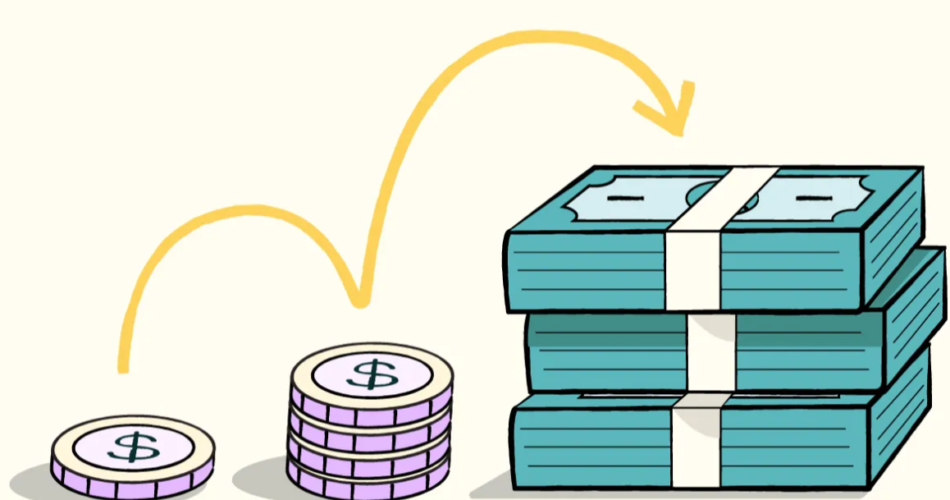Compound interest is a powerful financial concept that can help you grow your money faster than you might imagine. It’s the principle of earning interest on both your initial investment and the interest that accumulates over time. This process can significantly increase your wealth if used wisely and consistently.
In this article, we’ll break down the idea of compound interest, show how it works, and explain why it’s considered one of the most effective tools in personal finance. You’ll learn how it compares to simple interest, how to calculate it, and how you can use it to your advantage.
Contents
Understanding the Basics

What Is It?
When you invest money or place it in a savings account, you typically earn interest. With simple interest, you’re paid based only on your original deposit. But with compounding, your interest earns interest too. This results in exponential growth over time.
For example, if you invest $1,000 at a 5% annual interest rate:
- With simple interest, after 3 years, you’d earn $150 (5% of $1,000 x 3).
- With compounding, you’d earn more because each year your interest is added to the balance, and the new total earns even more interest.
Key Terms to Know:
- Principal: The original amount of money you invest or save.
- Interest Rate: The percentage at which your money grows.
- Compounding Frequency: How often interest is added to your account (annually, quarterly, monthly, daily).
- Time: The longer your money stays invested, the more it grows.
How It Works
Let’s break it down with a simple scenario:
You invest $1,000 at a 5% annual rate compounded annually.
- Year 1: $1,000 × 5% = $50 → New total = $1,050
- Year 2: $1,050 × 5% = $52.50 → New total = $1,102.50
- Year 3: $1,102.50 × 5% = $55.13 → New total = $1,157.63
Instead of just earning $150 like you would with simple interest, you earn $157.63 in three years due to compounding.
The more often interest is compounded, the faster your money grows. Daily compounding earns more than monthly, and monthly earns more than annually.
Why It’s So Powerful
Albert Einstein reportedly called it the “eighth wonder of the world.” Here’s why it’s so effective:
- It rewards patience: The longer you save, the more it grows.
- It encourages early saving: Starting young gives your money decades to grow.
- It’s exponential, not linear: Your growth accelerates over time.
- It reduces effort: You don’t need to add more money to earn more—your money does the work.
The Rule of 72
This rule is a simple formula to estimate how long it takes for your money to double using compound growth:
72 ÷ Interest Rate = Years to Double
So if your investment earns 6% annually:
72 ÷ 6 = 12 years to double your money
This is a handy way to visualize the impact of compounding on your savings or investments.
Compound Interest vs Simple Interest
| Feature | Simple Interest | Compound Interest |
|---|---|---|
| Growth Type | Linear | Exponential |
| Based On | Original principal | Principal + accumulated interest |
| Returns | Slower | Faster |
| Ideal For | Short-term loans | Long-term savings and investments |
How to Make It Work for You
1. Start Early
The earlier you begin, the more time your money has to grow.
2. Invest Regularly
Make consistent contributions. Even small, regular deposits make a big difference over time.
3. Choose High-Interest Accounts
Compare interest rates on savings accounts, CDs, or investment options.
4. Minimize Withdrawals
Letting your money sit undisturbed allows interest to compound effectively.
5. Reinvest Earnings
Instead of spending interest or dividends, reinvest them for faster growth.
Real-Life Examples
Example 1: Savings Account
You deposit $5,000 in a savings account with 4% annual interest compounded monthly. After 20 years, your balance grows to over $11,000—even without additional deposits.
Example 2: Retirement Fund
If you invest $200/month starting at age 25 in a retirement account earning 7% annually, by age 65 you’d have over $500,000. If you waited until age 35 to start, you’d have around $245,000—less than half.
Using It in Daily Life
You don’t have to be wealthy to take advantage of this concept:
- Use a high-yield savings account.
- Invest in stocks, index funds, or ETFs.
- Open a retirement account like a 401(k) or IRA.
- Contribute to your child’s education fund.
Over time, your consistent effort will be multiplied thanks to this compounding effect.
Common Questions
Q: How often is interest compounded? A: It varies by account—daily, monthly, quarterly, or annually. Daily compounding earns more.
Q: Is compound interest guaranteed? A: It depends on the account. Savings accounts and CDs offer guaranteed returns. Investments like stocks do not.
Q: What’s the best way to benefit from it? A: Start early, contribute regularly, and choose accounts with strong, consistent returns.
Q: Does it work for loans too? A: Yes, but in reverse. Loans like credit cards use compounding against you. Interest grows on your balance.
Mistakes to Avoid
- Waiting too long to start saving
- Withdrawing interest instead of reinvesting
- Focusing only on principal and not on time
- Ignoring high-interest debt that compounds against you
Tools to Help
- Compound Interest Calculators: Available online to forecast growth.
- Budgeting Apps: Help you save more and track investments.
- Financial Planners: Provide guidance tailored to your goals.
Final Thoughts
The earlier and more consistently you take advantage of this principle, the greater your financial growth. Whether you’re saving for retirement, a house, or your child’s education, compounding can turn small efforts into big results.
Start today, and let your money grow itself. This simple concept has the potential to transform your financial future. Embrace it, and watch your savings take off!
